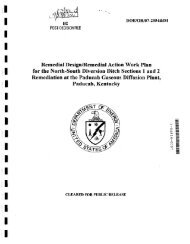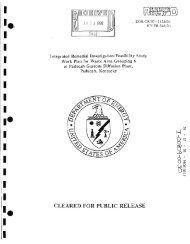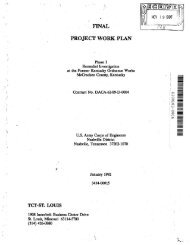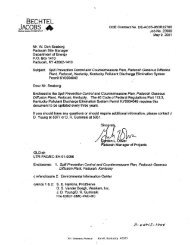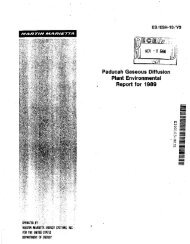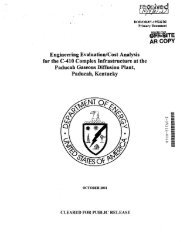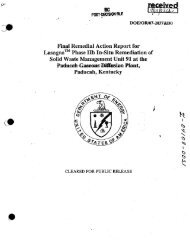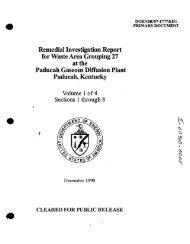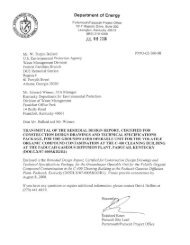1 - paducah environmental information center
1 - paducah environmental information center
1 - paducah environmental information center
Create successful ePaper yourself
Turn your PDF publications into a flip-book with our unique Google optimized e-Paper software.
Paducah Site<br />
congener - Any particular member of a class of<br />
chemical substances. A specific congener is<br />
denoted by a unique chemical structure.<br />
contained landfill - A solid waste site or facility<br />
that accepts for disposal of solid waste. The<br />
technical requirements for contained landfills<br />
are found in 401 KAR 47:080, 48:050, and<br />
48:070 to 48:090.<br />
contamination - Deposition of unwanted<br />
material on the surfaces of structures, areas,<br />
objects, or personnel.<br />
cosmic radiation - Ionizing radiation with very<br />
high energies that originates outside the earth's<br />
atmosphere. Cosmic radiation is one contributor to<br />
natural background radiation.<br />
curie (Ci) ~ A unit of radioactivity. One curie is<br />
dermed as 3.7 x 1010 (37 billion) disintegrations per<br />
second. Several fractions and mUltiples of the<br />
curie are commonly used:<br />
radioactive or nonradioactive nuclide or into a<br />
different energy state of the same radionuclide.<br />
dense nonaqueous phase liquid (DNAPL) - The<br />
liquid phase of chlorinated organic solvents. These<br />
liquids are denser than water and include<br />
commonly used industrial compounds such as<br />
tetrachloroethylene and trichloroethylene.<br />
derived concentration guide (DCG) - The<br />
concentration of a radionuclide in air or water<br />
that under conditions of continuous exposure for<br />
one year by one exposure mode (i.e., ingestion<br />
of water, submersion in air, or inhalation) would<br />
result in either an effective dose equivalent of O. 1<br />
rem (1 mSv) or a dose equivalent of 5 rem (50 mSv)<br />
to any tissue, including skin and the lens of the eye.<br />
The guidelines for ntdionuclides in air and water<br />
are given in DOE Order 5400.5, Radiation<br />
Protection of the Public arid the Environment.<br />
disintegration, nuclear - A spontaneous nuclear<br />
transformation (radioactivity) characterized by the<br />
emission of energy and/or mass. from the nucleus<br />
of an atom. .<br />
• kilocurie (kCi) - 10 3 Ci, one thousand<br />
curies; 3.7 x 1013 disintegrations per<br />
second.<br />
• millicurie (mCl) - 10- 3 Ci, one-thousandth<br />
of a curie; 3.7 x 10 7 disintegrations per<br />
second.<br />
• microcurie (pCi) - 10-6 Ci, one-millionth<br />
of a curie; 3.7 x 10 4 disintegrations per<br />
second.<br />
• picocurie (pCi) - 10- 12 Ci, one-trillionth of<br />
a curie; 3.7 x 10- 2 disintegrations per<br />
second.<br />
daughter - A nuclide formed by the radioactive<br />
decay of a parent nuclide.<br />
decay, radioactive - The spontaneous<br />
transformation of one.radionuclide into a different<br />
dose - The energy imparted to matter by ionizing<br />
radiation. The unit of absorbed dose is the rad,<br />
equal to 0.01 joules per kilogram in any medium.<br />
• absorbed dose - The quantity of radiation<br />
energy absorbed by an organ divided by<br />
the organ's mass. Absorbed dose is<br />
expressed in units of rad (or gray) (1 rad =<br />
0.01 Gy).<br />
• dose equivalent - The product of the<br />
absorbed dose (rad) in tissue and a quality<br />
factor. Dose equivalent is expressed in<br />
units of rem (or sievert) (1 rem';' 0.01 Sv).<br />
• committed dose equivalent - The<br />
calculated total dose equivalent to a tissue<br />
or organ over a 50-year period after known<br />
intake of a radionuclide into the body.<br />
Contributions from external dose are not<br />
G-2<br />
Glossary



